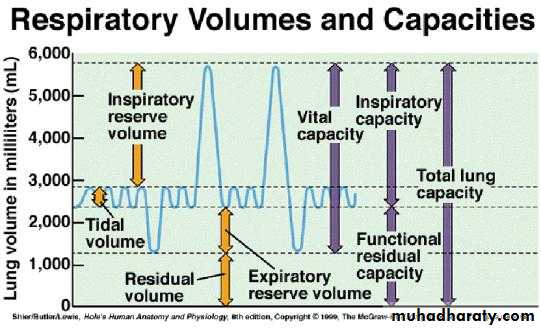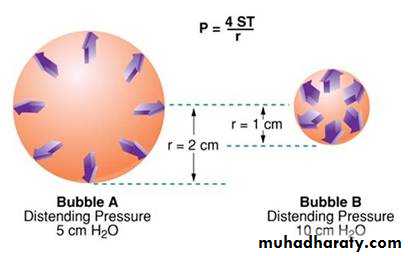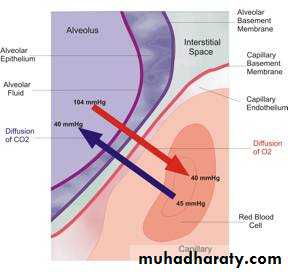Pulmonary Function
By pharmacistMaha A. Hamdi
Reference :ganong review of medical physiology
Respiration, includes two processes:
external respiration, the absorption of O2 and removal of CO2 from the body as a whole;internal respiration, the utilization of O2 and production of CO2 by cells and the gaseous exchanges between the cells and their fluid medium.
Partial Pressures
the volume occupied by a given number of gas molecules at a given temperature and pressure is (ideally) the same regardless of the composition of the gas.the pressure exerted by any one gas in a mixture of gases (its partial pressure) is equal to the total pressure times the fraction of the total amount of gas it represents.
Pp= total p *fraction of a gas
The composition of dry air is 20.98% O2, 0.04% CO2, 78.06% N2, and 0.92% other inert constituents such as argon and helium.
The barometric pressure (PB) at sea level is 760 mm Hg (1 atmosphere).
pO2 in dry air is therefore 0.21 x 760, or 160 mm Hg at sea level.
Gas diffuses from areas of high pressure to areas of low pressure,
with the rate of diffusion depending on:
1- the concentration gradient
2-and the nature of the barrier between the two areas.
a mixture of gases is in contact with liquid and permitted to equilibrate with a liquid, each gas in the mixture dissolves in the liquid to an extent determined by its partial pressure and its solubility in the fluid.
Mechanismof Respiration
lungs and the chest wall are elastic structures.a thin layer of fluid is present between the lungs and the chest wall (intrapleural space).
lungs slide easily on the chest wall, but resist being pulled away from it in the same way that two moist pieces of glass slide on each other but resist separation.
pressure in the "space" between the lungs and chest wall (intrapleural pressure) is subatmospheric.
Inspiration is an active process.
contraction of the inspiratory muscles increases intrathoracic volume.
intrapleural pressure at the base of the lungs, which is normally about –2.5 mm Hg (relative to atmospheric) at the start of inspiration, decreases to about –6 mm Hg.
pressure in the airway becomes slightly negative,
and air flows into the lungs
At the end of inspiration, the lung recoil begins to pull the chest back to the expiratory position, where the recoil pressures of the lungs and chest wall balance.
The pressure in the airway becomes slightly positive,
and air flows out of the lungs.
Expiration during quiet breathing is passive in the sense that no muscles that decrease intrathoracic volume contraction
Lung Volumes
pulmonary ventilation, respiratory minute volume) is normally about 6 L
(500 mL/ breath x 12 breaths/min).
Lung Volumes
tidal volume:amount of air that moves into the lungs with each inspiration (or the amount that moves out with each expiration).inspiratory reserve volume:air inspired with a maximal inspiratory effort in excess of the tidal volume.
expiratory reserve volume:volume expelled by an active expiratory effort after passive expiration .
residual volume:air left in the lungs after a maximal expiratory effort .
forced vital capacity (FVC):the largest amount of air that can be expired after a maximal inspiratory effort,Measured as an index of pulmonary function.
FEV1:fraction of the vital capacity expired during the first second of a forced expiration.
The FEV1 to FVC ratio (FEV1/FVC) is a useful tool in the diagnosis of airway disease.
Compliance of the Lungs & Chest Wallcompliance (stretchability): The change in lung volume per unit change in airway pressure (ΔV/ΔP).
resistance of the lung and chest is the pressure difference required for a unit of air to flow; this measurement, which is dynamic rather than static, also takes into account the resistance to air flow in the airways.
Alveolar Surface Tension
is the surface tension of the film of fluid that lines the alveoli.
& affecting the compliance of the lungs .
Surfactant: a lipid surface-tension-lowering agent.
Surfactant is a mixture of dipalmitoylphosphatidylcholine (DPPC), other lipids, and proteins.
If the surface tension is not kept low when the alveoli become smaller during expiration, they collapse.
Surfactant also helps to prevent pulmonary edema.
Work of Breathing
Work is performed by the respiratory muscles in stretching the elastic tissues of the chest wall and lungs (elastic work; 65% of the total work),moving inelastic tissues (viscous resistance; 7% of total),
and moving air through the respiratory passages (airway resistance; 28% of total).
the total work of quiet breathing range from 0.3 up to 0.8 kg-m/min. &rises during exercise.
work of breathing is greatly increased in diseases such as emphysema, asthma, and congestive heart failure with dyspnea and orthopnea.
Ventilation & Blood Flow in Different Parts of the Lung
upright position, ventilation per unit lung volume is greater at the base of the lung than at the apex.reason for this is that at the start of inspiration, intrapleural pressure is less negative at the base than at the apex.
ventilation/perfusion ratio is low at the base and high at the apex.
ventilation and perfusion differences from the apex to the base of the lung have usually been attributed to gravity & tend to disappear in the supine position,Dead Space & Uneven Ventilation
gaseous exchange in the respiratory system occurs only in the terminal portions of the airways, the gas that occupies the rest of the respiratory system is not available for gas exchange with pulmonary capillary blood= anatomic dead space =first 350 mL of the 500 mL inspired with each breathtotal (physiologic) dead space (volume of gas not equilibrating with blood; ie, wasted ventilation).
Sampling Alveolar Air
Diffusion Across the Alveolocapillary Membrane
Gases diffuse from the alveoli to the blood in the pulmonary capillaries or vice versa across the thin alveolocapillary membrane made up of the pulmonary epithelium, the capillary endothelium, and their fused basement membranes, reach equilibrium in the 0.75 sfor example, the anesthetic gas nitrous oxide (N2O) does not react and reaches equilibrium in about 0.1 s .
the amount of N2O taken up is not limited by diffusion but by the amount of blood flowing through the pulmonary capillaries; that is, it is flow-limited.
carbon monoxide (CO) is taken up by hemoglobin in the red blood cells at such a high rate that the partial pressure of CO in the capillaries stays very low and equilibrium is not reached in the 0.75 s with blood in the pulmonary capillaries.
Therefore, the transfer of CO is not limited by perfusion at rest and instead is diffusion-limited
O2 is intermediate between N2O and CO; it is taken up by hemoglobin, but much less avidly than CO, and it reaches equilibrium with capillary blood in about 0.3 s. Thus, its uptake is perfusion-limited.
The diffusing capacity of the lung for a given gas is directly proportionate to the surface area of the alveolocapillary membrane and inversely proportionate to its thickness.
Ventilation/Perfusion Ratios
The ratio of pulmonary ventilation to pulmonary blood flow for the whole lung at rest is 0.8 (4.2 L/min ventilation divided by 5.5 L/min blood flow).marked differences occur in this ventilation/perfusion ratio in various parts of lung as a result of the effect of gravity, and local changes in the ventilation/perfusion ratio are common in disease.
If the ventilation to an alveolus is reduced relative to its perfusion, the PO2 in the alveolus falls because less O2 is delivered to it and the PCO2 rises because less CO2 is expired
Conversely, if perfusion is reduced relative to ventilation, the PCO2 falls because less CO2 is delivered and the PO2 rises because less O2 enters the blood
Other Functions of the Respiratory System
1-Lung Defense MechanismsAirway epithelial cells can secrete immunoglobulins (IgA), collectins (including Surfactant A and D), defensins and other peptides and proteases, reactive oxygen species, and reactive nitrogen species, act directly as antimicrobials
do
2-Metabolic & Endocrine Functions
Synthesized and used in the lungsSurfactant
Synthesized or stored and released into the blood
Prostaglandins
Histamine
Kallikrein
Partially removed from the blood
Prostaglandins
Bradykinin
Adenine nucleotides
Serotonin
Norepinephrine
Acetylcholine
Activated in the lungs
Angiotensin I → angiotensin II







